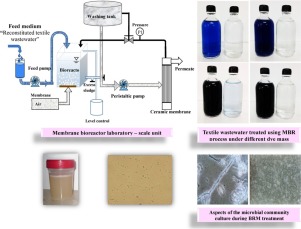当前位置:
X-MOL 学术
›
Process Saf. Environ. Prot.
›
论文详情
Our official English website, www.x-mol.net, welcomes your feedback! (Note: you will need to create a separate account there.)
Assessing the performances of an aerobic membrane bioreactor for textile wastewater treatment: Influence of dye mass loading rate and biomass concentration
Process Safety and Environmental Protection ( IF 7.8 ) Pub Date : 2020-03-01 , DOI: 10.1016/j.psep.2020.01.011 Imen Khouni , Ghofrane Louhichi , Ahmed Ghrabi
Process Safety and Environmental Protection ( IF 7.8 ) Pub Date : 2020-03-01 , DOI: 10.1016/j.psep.2020.01.011 Imen Khouni , Ghofrane Louhichi , Ahmed Ghrabi

|
Abstract Textile industry is being a very demanding consumer of high-quality water with highest wastewater discharge. Membrane bioreactor (MBR) was employed widely to treat dying effluents due to its distinct advantages over conventional techniques. This study investigated the potential of biological treatment employing a microbial community ‘IHK22′ under MBR laboratory-scale conditions to decolourize reconstituted textile wastewater in order to be reused. First, the bioreactor was conducted at a low biomass concentration of 4 gMLVSS⋅L−1. Decolourization performances were maintained at very high rates (91–100 %) for dye mass loading rates in the range of 1.25–2.5 mg⋅gMLVSS-1⋅d-1. Then, the dye concentration was increased to 7.5 mg⋅gMLVSS-1⋅d-1, the decolourization performances of the MBR have been affected (80–87 %). When the biomass concentration has been increased to 8 gMLVSS⋅L−1, thus, a total MBR decolourization was then observed (100 %). Under 320 mg⋅gMLVSS-1⋅d-1 and regardless of the operating period of the MBR, all the microorganisms and microfiltration membrane allow the elimination of most soluble organic matter of the treated effluent (80–90 %). Obtained results indicate that the dye mass loading rate can influence the efficiency of dye removal through an MBR. The use of an appropriate biomass concentration significantly improves the MBR performances for an effective textile wastewater treatment.
中文翻译:

评估用于纺织废水处理的好氧膜生物反应器的性能:染料质量负载率和生物质浓度的影响
摘要 纺织业是高品质水的高要求消费者,废水排放量最高。膜生物反应器 (MBR) 因其优于传统技术的独特优势而被广泛用于处理死亡废水。本研究调查了在 MBR 实验室规模条件下采用微生物群落“IHK22”进行生物处理的潜力,以对重构的纺织废水进行脱色以便重复使用。首先,生物反应器在 4 gMLVSS⋅L−1 的低生物量浓度下进行。对于 1.25-2.5 mg⋅gMLVSS-1⋅d-1 范围内的染料质量负载率,脱色性能保持在非常高的速率 (91-100%)。然后,染料浓度增加到 7.5 mg·gMLVSS-1·d-1,MBR 的脱色性能受到影响(80-87%)。当生物量浓度增加到 8 gMLVSS⋅L−1 时,观察到 MBR 总脱色(100%)。在 320 mg·gMLVSS-1·d-1 下,无论 MBR 的运行时间如何,所有微生物和微滤膜都可以去除处理出水的大部分可溶性有机物(80-90%)。获得的结果表明,染料载量速率会影响通过 MBR 去除染料的效率。使用适当的生物质浓度可以显着提高 MBR 性能,以实现有效的纺织废水处理。所有微生物和微滤膜都可以去除处理过的污水中的大部分可溶性有机物 (80-90%)。获得的结果表明,染料质量加载速率会影响通过 MBR 去除染料的效率。使用适当的生物质浓度可以显着提高 MBR 性能,以实现有效的纺织废水处理。所有的微生物和微滤膜都可以去除处理过的污水中的大部分可溶性有机物 (80-90%)。获得的结果表明,染料载量速率会影响通过 MBR 去除染料的效率。使用适当的生物质浓度可以显着提高 MBR 性能,以实现有效的纺织废水处理。
更新日期:2020-03-01
中文翻译:

评估用于纺织废水处理的好氧膜生物反应器的性能:染料质量负载率和生物质浓度的影响
摘要 纺织业是高品质水的高要求消费者,废水排放量最高。膜生物反应器 (MBR) 因其优于传统技术的独特优势而被广泛用于处理死亡废水。本研究调查了在 MBR 实验室规模条件下采用微生物群落“IHK22”进行生物处理的潜力,以对重构的纺织废水进行脱色以便重复使用。首先,生物反应器在 4 gMLVSS⋅L−1 的低生物量浓度下进行。对于 1.25-2.5 mg⋅gMLVSS-1⋅d-1 范围内的染料质量负载率,脱色性能保持在非常高的速率 (91-100%)。然后,染料浓度增加到 7.5 mg·gMLVSS-1·d-1,MBR 的脱色性能受到影响(80-87%)。当生物量浓度增加到 8 gMLVSS⋅L−1 时,观察到 MBR 总脱色(100%)。在 320 mg·gMLVSS-1·d-1 下,无论 MBR 的运行时间如何,所有微生物和微滤膜都可以去除处理出水的大部分可溶性有机物(80-90%)。获得的结果表明,染料载量速率会影响通过 MBR 去除染料的效率。使用适当的生物质浓度可以显着提高 MBR 性能,以实现有效的纺织废水处理。所有微生物和微滤膜都可以去除处理过的污水中的大部分可溶性有机物 (80-90%)。获得的结果表明,染料质量加载速率会影响通过 MBR 去除染料的效率。使用适当的生物质浓度可以显着提高 MBR 性能,以实现有效的纺织废水处理。所有的微生物和微滤膜都可以去除处理过的污水中的大部分可溶性有机物 (80-90%)。获得的结果表明,染料载量速率会影响通过 MBR 去除染料的效率。使用适当的生物质浓度可以显着提高 MBR 性能,以实现有效的纺织废水处理。



























 京公网安备 11010802027423号
京公网安备 11010802027423号